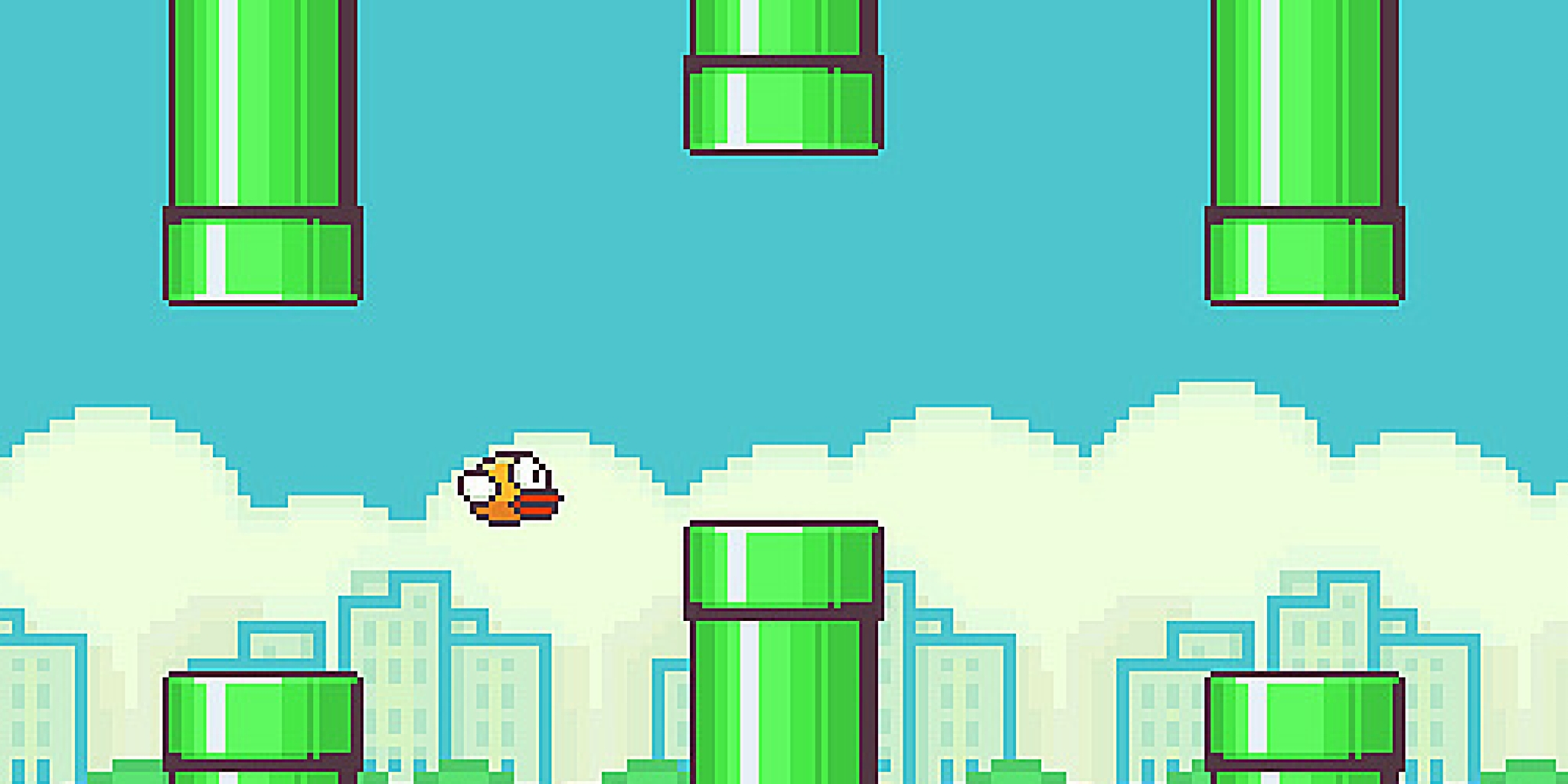FlappyBird
使用MLP与遗传算法玩FlappyBird GitHub链接

所需环境
代码 Code
MLP神经网络 neural network controller
import numpy as np
import math
class MLP(object):
def __init__(self, numInput, numHidden1, numHidden2, numOutput):
self.fitness = 0
self.numInput = numInput + 1 # Add bias node from input to hidden layer␣ →1 only
self.numHidden1 = numHidden1 # Feel free to adapt the code to add more␣ →biases if you wish
self.numHidden2 = numHidden2
self.numOutput = numOutput
self.w_i_h1 = np.random.randn(self.numHidden1, self.numInput)
self.w_h1_h2 = np.random.randn(self.numHidden2, self.numHidden1)
self.w_h2_o = np.random.randn(self.numOutput, self.numHidden2)
self.ReLU = lambda x : max(0,x)
def sigmoid(self, x):
try:
ans = (1 / (1 + math.exp(-x)))
except OverflowError:
ans = float('inf')
return ans
class MLP(MLP):
def feedForward(self, inputs):
inputsBias = inputs[:]
inputsBias.insert(len(inputs), 1)
h1 = np.dot(self.w_i_h1, inputsBias)
h1 = [self.ReLU(x) for x in h1]
h2 = np.dot(self.w_h1_h2, h1)
h2 = [self.ReLU(x) for x in h2]
output = np.dot(self.w_h2_o, h2)
output = [self.sigmoid(x) for x in output]
return output
class MLP(MLP):
def getWeightsLinear(self):
flat_w_i_h1 = list(self.w_i_h1.flatten())
flat_w_h1_h2 = list(self.w_h1_h2.flatten())
flat_w_h2_o = list(self.w_h2_o.flatten())
return (flat_w_i_h1 + flat_w_h1_h2 + flat_w_h2_o)
def setWeightsLinear(self, Wgenome):
numWeights_I_H1 = self.numHidden1 * self.numInput
numWeights_H1_H2 = self.numHidden2 * self.numHidden1
numWeights_H2_O = self.numOutput * self.numHidden2
self.w_i_h1 = np.array(Wgenome[:numWeights_I_H1])
self.w_i_h1 = self.w_i_h1.reshape((self.numHidden1, self.numInput))
self.w_h1_h2 = np.array(Wgenome[numWeights_I_H1:(numWeights_H1_H2+numWeights_I_H1)])
self.w_h1_h2 = self.w_h1_h2.reshape((self.numHidden2, self.numHidden1))
self.w_h2_o = np.array(Wgenome[(numWeights_H1_H2 + numWeights_I_H1):])
self.w_h2_o = self.w_h2_o.reshape((self.numOutput, self.numHidden2))
游戏 Game
import pygame
class FlappyBird:
def __init__(self):
self.screen = pygame.display.set_mode((400, 708))
self.bird = pygame.Rect(65, 50, 50, 50)
self.background = pygame.image.load("assets/background.png").convert()
self.birdSprites = [pygame.image.load("assets/1.png").convert_alpha(),
pygame.image.load("assets/2.png").convert_alpha(),
pygame.image.load("assets/dead.png")]
self.wallUp = pygame.image.load("assets/bottom.png").convert_alpha()
self.wallDown = pygame.image.load("assets/top.png").convert_alpha()
self.gap = 130
self.gravity = 5
self.delay = False
self.restart()
def updateWalls(self):
self.wallx -= 5
self.distanceMoved += 5
if self.wallx < -80:
self.wallx = 400
self.counter += 1
self.offset = np.random.randint(-180, 200)
def birdUpdate(self):
if self.jump:
self.jumpSpeed -= 1
self.birdY -= self.jumpSpeed
self.jump -= 1
else:
self.birdY += self.gravity
self.gravity += 0.2
self.bird[1] = self.birdY
upRect = pygame.Rect(self.wallx,
360 + self.gap - self.offset + 10,
self.wallUp.get_width() - 10,
self.wallUp.get_height())
downRect = pygame.Rect(self.wallx,
0 - self.gap - self.offset - 10,
self.wallDown.get_width() - 10,
self.wallDown.get_height())
if upRect.colliderect(self.bird):
self.dead = True
if downRect.colliderect(self.bird):
self.dead = True
if not 0 < self.bird[1] < 720:
self.dead = True
def updateScreen(self):
font = pygame.font.SysFont("Arial", 50)
self.screen.fill((255, 255, 255))
self.screen.blit(self.background, (0, 0))
self.wallUpY = 360 + self.gap - self.offset
self.wallDownY = 0 - self.gap - self.offset
self.screen.blit(self.wallUp, (self.wallx, self.wallUpY))
self.screen.blit(self.wallDown, (self.wallx, self.wallDownY))
self.screen.blit(font.render(str(self.counter), -1, (255, 255, 255)),(200, 50))
self.screen.blit(self.birdSprites[self.sprite], (70, self.birdY))
def makeJump(self):
self.jump = 17
self.gravity = 5
self.jumpSpeed = 10
def restart(self):
self.wallx = 400
self.wallUpY = 0
self.wallDownY = 0
self.birdY = 400
self.jump = 0 # A timer for the jump
self.jumpSpeed = 10
self.dead = False
self.sprite = 1
self.distanceMoved = 0
self.counter = 0
self.stepsSinceLastJump = 0
self.offset = np.random.randint(-180, 300)
def run(self, network):
pygame.font.init()
while self.dead == False:
for event in pygame.event.get():
if event.type == pygame.QUIT:
sys.exit()
if (event.type == pygame.KEYDOWN) and not self.dead:
#self.makeJump()
if self.delay:
self.delay = False
else:
self.delay = True
if self.delay: time.sleep(0.01)
# We don't want it going on forever, so set an upper limit
if self.counter == 10:
self.dead = True
self.xdiff = 70 - self.wallx
ydiffUp = self.birdY - self.wallUpY
ydiffDown = self.birdY - self.wallDownY
decision = network.feedForward([self.xdiff, ydiffUp, ydiffDown])
if decision[0] > 0.5 and not self.dead:
self.makeJump()
self.updateScreen()
self.updateWalls()
self.birdUpdate()
pygame.display.update()
return self.distanceMoved
遗传算法 The Genetic Algorithm
from deap import base
from deap import creator
from deap import tools
import random
import time
numInputNodes = 3
numHiddenNodes1 = 3
numHiddenNodes2 = 2
numOutputNodes = 1
IND_SIZE = ((numInputNodes+1) * numHiddenNodes1) + (numHiddenNodes1 * numHiddenNodes2) + (numHiddenNodes2 * numOutputNodes)
Create a single neural network controller that we will use. We will evolve weights and pass them to this network when we need to evaluate their fitness.
myNet = MLP(numInputNodes, numHiddenNodes1, numHiddenNodes2, numOutputNodes)
creator.create("FitnessMax", base.Fitness, weights=(1.0,))
creator.create("Individual", list, fitness=creator.FitnessMax)
toolbox = base.Toolbox()
toolbox.register("attr_float", random.uniform, -1.0, 1.0)
toolbox.register("individual", tools.initRepeat, creator.Individual,toolbox.attr_float, n=IND_SIZE)
def evaluate(indiv, myNet, game):
myNet.setWeightsLinear(indiv) # Load the individual's weights into the neural network
game.restart()
fitness = game.run(myNet) # Evaluate the individual by running the game (discuss)
return fitness,
toolbox.register("evaluate", evaluate)
toolbox.register("select", tools.selTournament, tournsize=3)
toolbox.register("mutate", tools.mutGaussian, mu=0.0, sigma=0.5, indpb=0.1)
toolbox.register("population", tools.initRepeat, list, toolbox.individual)
stats = tools.Statistics(key=lambda ind: ind.fitness.values)
stats.register("avg", np.mean)
stats.register("std", np.std)
stats.register("min", np.min)
stats.register("max", np.max)
logbook = tools.Logbook()
pop = toolbox.population(n=100)
Create a single game object. We will use this single object evaluate each of our solutions.
game = FlappyBird()
fitnesses = [toolbox.evaluate(indiv, myNet, game) for indiv in pop]
for ind, fit in zip(pop, fitnesses):
ind.fitness.values = fit
NGEN = 10
for g in range(NGEN):
print("-- Generation %i --" % g)
offspring = toolbox.select(pop, len(pop))
offspring = list(map(toolbox.clone, offspring))
for mutant in offspring:
toolbox.mutate(mutant)
del mutant.fitness.values
invalid_ind = [ind for ind in offspring if not ind.fitness.valid]
fitnesses = [toolbox.evaluate(indiv, myNet, game) for indiv in invalid_ind]
for ind, fit in zip(invalid_ind, fitnesses):
ind.fitness.values = fit
pop[:] = offspring
record = stats.compile(pop)
logbook.record(gen=g, **record)
检验算法 Examination of the algorithm
logbook.header = "gen", "avg", "evals", "std", "min", "max"
import matplotlib.pyplot as plt
%matplotlib inline
gen = logbook.select("gen")
avgs = logbook.select("avg")
stds = logbook.select("std")
plt.rc('axes', labelsize=14)
plt.rc('xtick', labelsize=14)
plt.rc('ytick', labelsize=14)
plt.rc('legend', fontsize=14)
fig, ax1 = plt.subplots()
line1 = ax1.errorbar(gen, avgs, yerr=stds, errorevery=2)
ax1.set_xlabel("Generation")
ax1.set_ylabel("Mean Fitness")
检验最优解 Examine the best solution
indiv1 = tools.selBest(pop, 1)[0]
toolbox.evaluate(indiv1, myNet, game)